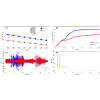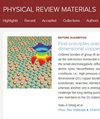利用热导率各向异性实现无铅室温铁电导热开关
IF 3.4
3区 材料科学
Q2 MATERIALS SCIENCE, MULTIDISCIPLINARY
引用次数: 0
摘要
按需控制热导率的材料是制造热导率开关的先决条件,在这种开关中,热导率可以开启或关闭。然而,理想的开关虽然是开发固态制冷、能量收集甚至声波电路的新方法所必需的,但目前仍然缺失。它应该只由活性材料组成,对环境友好,在室温附近工作,具有可逆、快速和大开关比。在这里,我们首先通过ab initio 电子结构计算预测钛酸钡中的铁电畴会表现出各向异性的热导率。通过对钛酸钡单晶体进行频域热反射和扫描热显微镜测量,我们证实了这一预测。然后,我们利用这些知识提出了一种无铅导热开关,它不含非活性材料,在电场作用下可逆运行。在室温下,我们发现开关比为 1.6±0.3,超过了建议用于导热开关的最先进材料的性能。本文章由计算机程序翻译,如有差异,请以英文原文为准。

Lead-free room-temperature ferroelectric thermal conductivity switch using anisotropies in thermal conductivities
Materials with on-demand control of thermal conductivity are the prerequisites to build thermal conductivity switches, where the thermal conductivity can be turned on and off. However, the ideal switch, while required to develop novel approaches to solid-state refrigeration, energy harvesting, and even phononic circuits, is still missing. It should consist of an active material only, be environment friendly, and operate near room temperature with a reversible, fast, and large switching ratio. Here, we first predict by ab initio electronic structure calculations that ferroelectric domains in barium titanate exhibit anisotropic thermal conductivities. We confirm this prediction by combining frequency-domain thermoreflectance and scanning thermal microscopy measurements on a single crystal of barium titanate. We then use this gained knowledge to propose a lead-free thermal conductivity switch without inactive material, operating reversibly with an electric field. At room temperature, we find a switching ratio of , exceeding the performances of state-of-the-art materials suggested for thermal conductivity switches.
求助全文
通过发布文献求助,成功后即可免费获取论文全文。
去求助
来源期刊

Physical Review Materials
Physics and Astronomy-Physics and Astronomy (miscellaneous)
CiteScore
5.80
自引率
5.90%
发文量
611
期刊介绍:
Physical Review Materials is a new broad-scope international journal for the multidisciplinary community engaged in research on materials. It is intended to fill a gap in the family of existing Physical Review journals that publish materials research. This field has grown rapidly in recent years and is increasingly being carried out in a way that transcends conventional subject boundaries. The journal was created to provide a common publication and reference source to the expanding community of physicists, materials scientists, chemists, engineers, and researchers in related disciplines that carry out high-quality original research in materials. It will share the same commitment to the high quality expected of all APS publications.
 求助内容:
求助内容: 应助结果提醒方式:
应助结果提醒方式:


